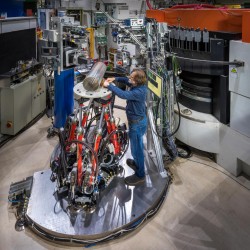Big science and industry join forces to innovate new space technologies
Research innovating the materials behind space technologies as well as their manufacturing methods will pave the way for more successful space missions and applications for use on Earth. In 2016, the global space economy totalled $345 billion (€296 / £262 billion) worldwide; developing innovative technologies is key to ensuring Europe continues to play an important role in this global and highly competitive sector. Pooling European science and engineering resources for industry, across research techniques, is critical for innovation in space research, technology and its applications. This ethos is echoed in an agreement signed by the ILL and ESRF, establishing the intent to collaborate with leading European space companies OHB System AG and MT Aerospace AG to further the field. As the world’s flagship neutron and synchrotron facilities, ILL and ESRF will unite their best-in-class resources, facilities and expertise to tackle challenges together with OHB System AG and MT Aerospace AG experts in the field of advanced characterisation of aerospace materials and fabrication processes. Together, the two sister companies boast more than 85 years of heritage in aerospace programs. Satellites by OHB System AG cover the whole range of satellite applications - from telecommunications, Earth observation, navigation, reconnaissance to exploration and science. MT Aerospace AG, a technological leader in lightweight metal and composite engineering, develops and delivers key components for Ariane launchers, aeronautics and space vehicles. Scientists and engineers are developing smarter materials and components to make more efficient devices and systems for space deployment. Mastering the methodologies that lead to new and better materials requires a detailed knowledge of their structure at the atomic or molecular level. As ILL’s neutrons are non-destructive and can explore deep inside matter, they are an ideal probe for most materials. ESRF’s high-energy non-destructive X-rays go far beyond lab-based X-ray beams, with their ability to penetrate deeply in large structures and provide atomic to micron-scale structural data using a huge range of techniques, including in situ micro- and nano-computed tomography (CT). Together the collaborators will conduct prototype manufacturing of new materials, progressing from multi-parameter studies through to qualifying models for testing and flight approval. Without the knowledge from the deep-penetrating techniques provided by ESRF and ILL, many of these steps would have to be repeated from the beginning, wasting time and resources. Working with ILL and ESRF will give OHB System AG and MT Aerospace AG access to a non-destructive investigation enabling investigation of large complex parts on the one hand, and electronic components and circuit boards on the other. “Europe operates the most powerful network of large scale materials characterisation facilities, among which the ESRF and ILL are the world-leading flagships for probing matter with X-rays and neutrons. Employing these tools for the benefit of Europe's space industry is an enormous opportunity to further develop Europe's competitiveness in this technology sector. The agreement with OHB System and MT Aerospace is laying the pioneering groundwork for fully seizing this opportunity,” says Professor Helmut Schober, Director of the ILL. ILL will provide OHB System AG and MT Aerospace AG users with unique access to a complete world-leading suite of highly specialised neutron instruments, supported by the expertise and know-how of experienced scientific and technical staff. Its extensive range of sample environment facilities accurately mimic real working conditions: extreme temperatures and pressures, magnetic fields, mechanical constraints - playing an essential role in the analysis of the in-operando industrial processes critical to accelerating their innovations. Full text and pictures: https://www.ill.eu/space-technologies-2018
Keywords
Neutron, Non-Destructive Investigation, Non-Destructive test, Large scale facilities
Countries
Germany, France



